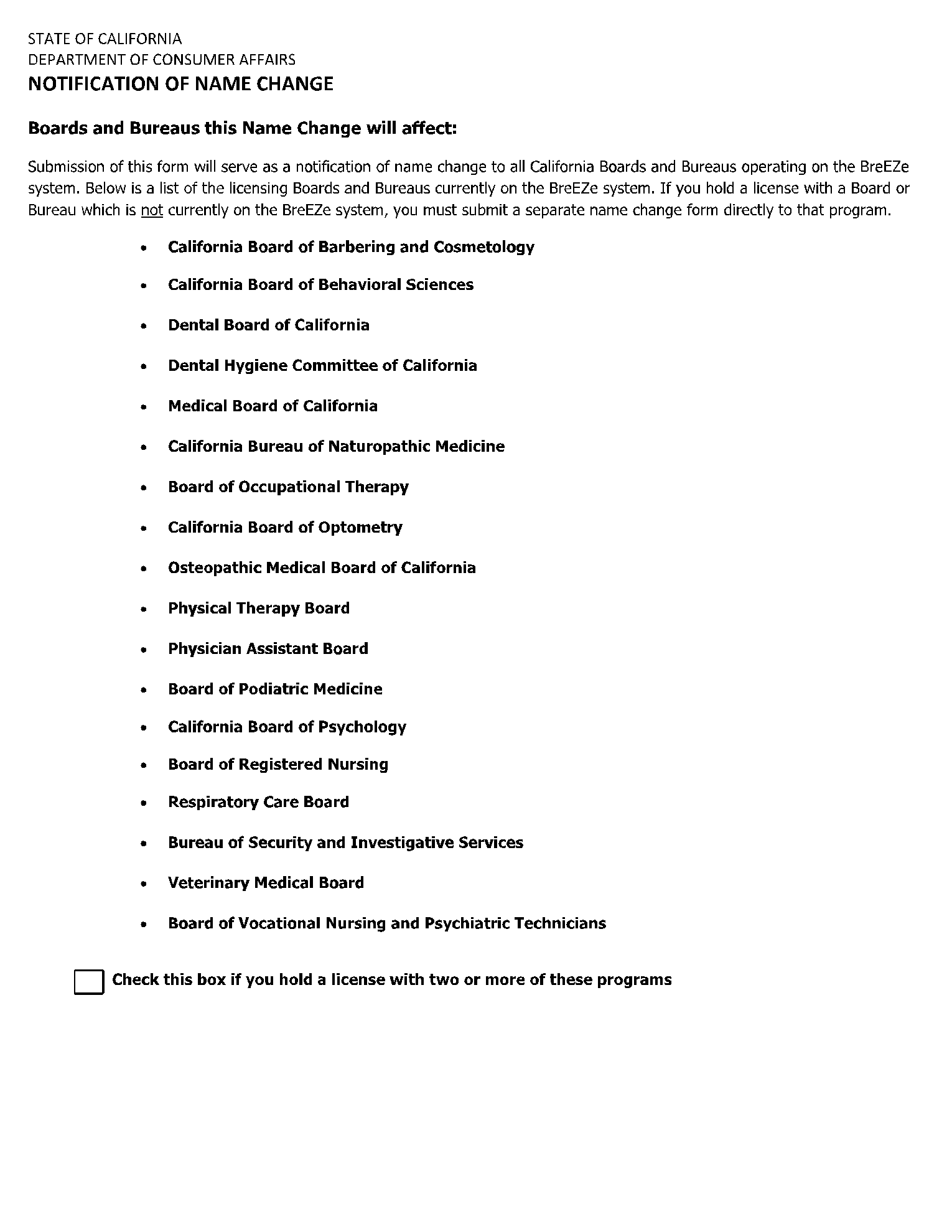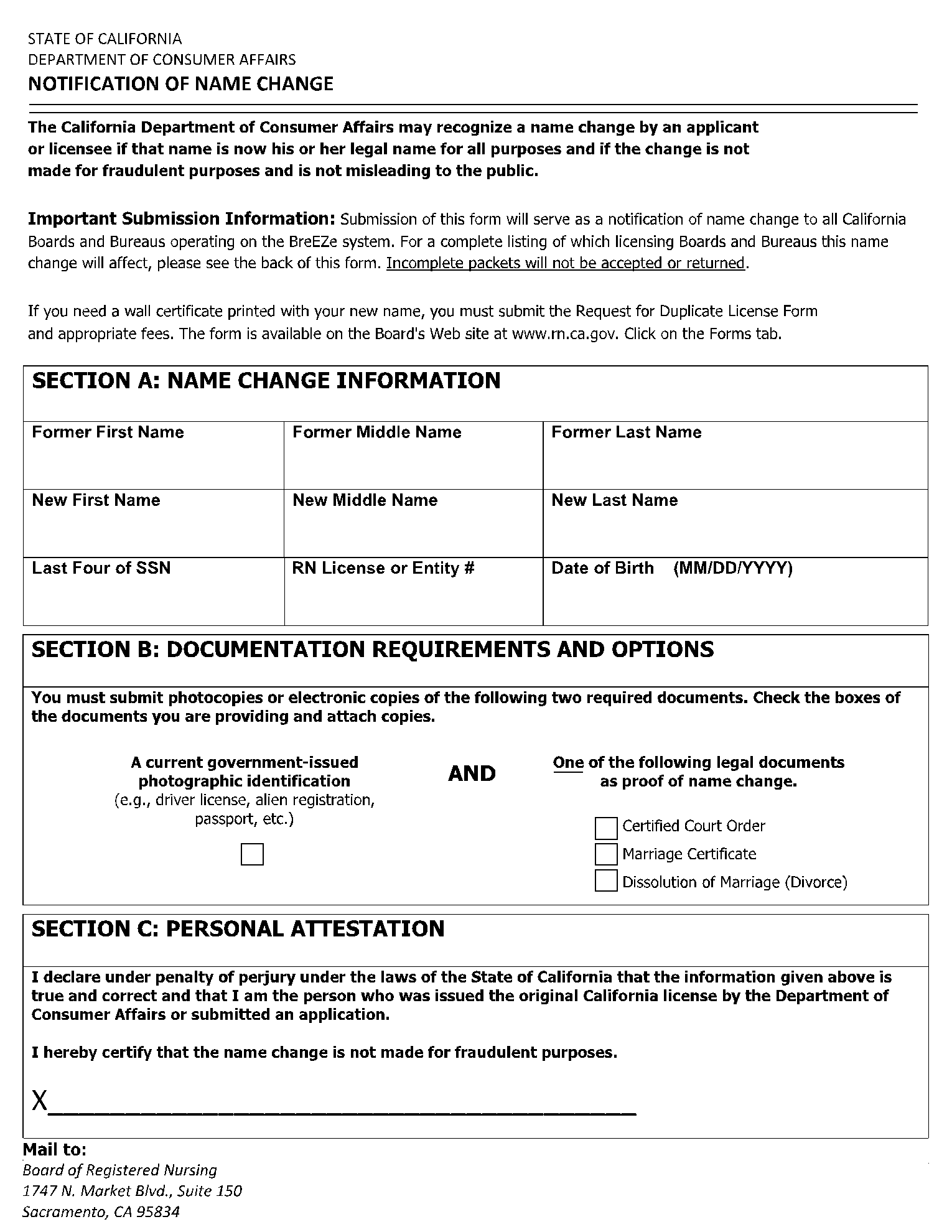Changing a name in California can be a little complicated depending on who’s petitioning for this name change – an adult or a child. Before this name change is approved, due process must be followed and certain requirements met.
The individual must also notify different places of this name change. The sections below answer questions like how to change your name in California, how much does it cost to change your name in California, the common name change cases in the state and the requirements that must be met.
The following are the information that should be included in a legal name change form for California:
- Former name
- New name
- Last four digits of SSN
- Registered Nurse (RN) license
- Date of birth
- Copies of government issued identification
- Signature
What Is a California Name Change Form & How Does It Work?
Residents of California are allowed by law to request for a name change. They do this by filing a California name change form. California courts would usually grant the petition if the reasons stated for the name change are deemed legitimate enough. However, whether or not the name change petition is granted is at the discretion of the court.
Asides finding the reasons for the name change good and sufficient, the court must also be able to see that it is in the interest of the public. If the change of name is for a minor child, the court must confirm that the name change is in the best interest of that minor child.
How to Legally Change Your Name in California?
Getting a court order in California after filing a Petition for Change of Name can take up to as much as three months. The individual would usually have a court date 6 to 12 weeks from when they filed the petition. If all the requirements are met and the court grants the request, the petitioner gets a court order also known as a decree to have their name changed.
The following are steps to be taken to have a court change one’s name in California
Fill out the required court forms:
The petitioner has the option of either completing their forms online or download and fill. The forms to be downloaded and filled include an Order to Show Cause for Change of Name (Form NC-120), Decree Changing Name Form (Form NC-13), Petition for Change of Name (Form NC-100) with the required attachment (Form NC-110).
Some courts also require that the individual fills certain local forms like a criminal background information form. Individuals who are requesting a change of name because they are in the State witness program or avoiding human trafficking and domestic violence are permitted by law to keep this change of name confidential.
Review the forms:
Consult a family law facilitator to help review the paperwork: This is to help ensure that the forms were well filled out.
Make copies:
All individuals making a request for a name change are advised to make at least two copies of all the forms. The court would usually keep the original copy, while the individual keeps one and the last is for publication in a newspaper. Not all name requests are to be made in the newspaper though. There are a few exceptions.
File with the court clerk:
Proceed to the court and have the forms stamped. The clerk of the court stamps the filled forms with “filed”, keeps the original and returns the other copies to you. On the Order to Show Cause, the individual should find information concerning their department number, court date and time. Filing these forms attract a fee. However, a resident of the state who can’t afford this fee is allowed to ask for a fee waiver.
Publish in a Newspaper (if required):
The petitioner might be required to publish the Order to Show Cause for Change of Name in a newspaper. The court will usually have a long line of newspapers that has been approved for publishing such notices.
The cost of publication is not fixed and cannot be waived by a fee waiver. An individual might not be required to publish in a newspaper if:
- It is a gender identity case
- The individual is in a state witness or address confidentiality program.
Serve documents if on parole or incarcerated:
If an individual is on parole or incarcerated, they are required to serve copies of Form NC-100, Form NC-110 and Form NC-120 in addition to publishing the Order to Show Cause.
Get the decree changing name:
The judge will proceed to sign the Decree changing name once the request for a change of name is approved. After getting the signed decree, the person should obtain a certified copy from the clerk of the court. With this certified copy, they can change the information on all their legal documents like social security card and birth certificate, among others.
What Are The Common Name Change Cases in California?
There are several reasons why one may want to change their name. They include:
- Marriage
- A divorce
- Because the name is associated with an infamous criminal
- Adoption
- Misspelled name
- Petitioner was a victim of identity theft
- Dissociating one’s self from a family name
Limitations and Requirements in Changing Names in California
The following are some of the limitations of changing your name in California. One cannot change their name to;
- Avoid debts
- Make fraudulent transactions
- Another name that could affect the rights of another individual, say a celebrity or public figure
- A name that contains a racial slur or curse word
- A name with punctuation and/or number
- If the person requesting for a name change is a minor, the court requires a written consent from an adult who retains the legal rights over the minor.
Before one can file for a name change as an adult in California, the following requirements must be met. The petitioner must:
- Reside in the state
- Be an adult of at least 18 years of age
- Not be requesting the name change to avoid creditors
- Not be mandated to register as a sex offender under Penal Code section 290
- Must reside in the county where the name change action is to be filed.
An individual who is not a convicted felon and meets the requirements for a name change in California such as filling the right forms, among others is likely to have their request granted. On CocoSign, you will find as many California name change forms as you need.

